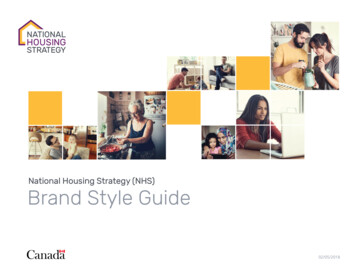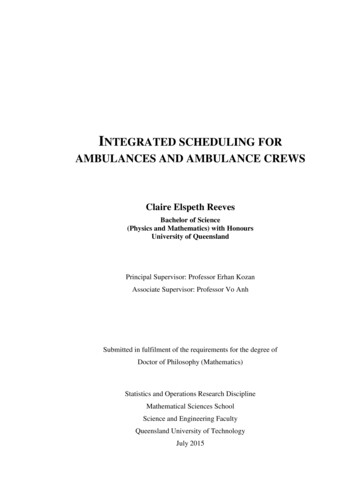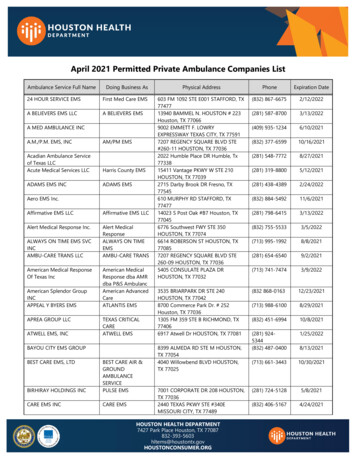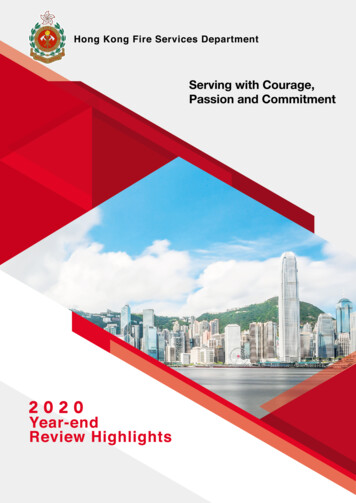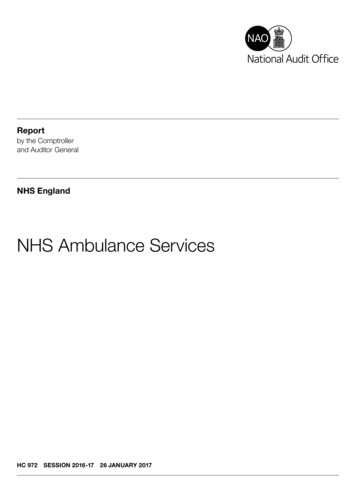
Transcription
Reportby the Comptrollerand Auditor GeneralNHS EnglandNHS Ambulance ServicesHC 972 SESSION 2016-17 26 JANUARY 2017
Our vision is to help the nation spend wisely.Our public audit perspective helps Parliament holdgovernment to account and improve public services.The National Audit Office scrutinises public spending for Parliament and is independentof government. The Comptroller and Auditor General (C&AG), Sir Amyas Morse KCB,is an Officer of the House of Commons and leads the NAO, which employs some785 people. The C&AG certifies the accounts of all government departments andmany other public sector bodies. He has statutory authority to examine and reportto Parliament on whether departments and the bodies they fund have used theirresources efficiently, effectively, and with economy. Our studies evaluate the value formoney of public spending, nationally and locally. Our recommendations and reportson good practice help government improve public services, and our work led toaudited savings of 1.21 billion in 2015.
NHS EnglandNHS Ambulance ServicesReport by the Comptroller and Auditor GeneralOrdered by the House of Commonsto be printed on 24 January 2017This report has been prepared under Section 6 of theNational Audit Act 1983 for presentation to the House ofCommons in accordance with Section 9 of the ActSir Amyas Morse KCBComptroller and Auditor GeneralNational Audit Office23 January 2017HC 972 10.00
This report reviews the progress that the NHS ambulanceservices have made since our previous report and that of theCommittee of Public Accounts. This report assesses whetherNHS ambulance services are providing value for money. National Audit Office 2017The material featured in this document is subject toNational Audit Office (NAO) copyright. The materialmay be copied or reproduced for non-commercialpurposes only, namely reproduction for research,private study or for limited internal circulation withinan organisation for the purpose of review.Copying for non-commercial purposes is subjectto the material being accompanied by a sufficientacknowledgement, reproduced accurately, and notbeing used in a misleading context. To reproduceNAO copyright material for any other use, you mustcontact copyright@nao.gsi.gov.uk. Please tell us whoyou are, the organisation you represent (if any) andhow and why you wish to use our material. Pleaseinclude your full contact details: name, address,telephone number and email.Please note that the material featured in thisdocument may not be reproduced for commercialgain without the NAO’s express and directpermission and that the NAO reserves its right topursue copyright infringement proceedings againstindividuals or companies who reproduce material forcommercial gain without our permission.Links to external websites were valid at the time ofpublication of this report. The National Audit Officeis not responsible for the future validity of the links.1140701/17NAO
ContentsKey facts 4Summary 5Part OneAmbulance services 12Part TwoAmbulance service performance 24Part ThreeService and financial sustainability 38Appendix OneProgress against the Committee ofPublic Accounts’ recommendations 52Appendix TwoOur audit approach 55Appendix ThreeOur evidence base 57Appendix FourServices provided and operating set-upby ambulance trust, 2016-17 59Appendix FiveAmbulance quality indicators 62Appendix SixResponse time targets across the UK 64Appendix SevenGreen call standards byNHS ambulance trust 66The National Audit Office study teamconsisted of:Leon Bardot, Helene Beaujet,Zoltan Bedocs, Sophie Judd,Alex Pullen, Ryan Whitlock andDavid Williams, under the directionof Robert White.This report can be found on theNational Audit Office website atwww.nao.org.ukFor further information about theNational Audit Office please contact:National Audit OfficePress Office157–197 Buckingham Palace RoadVictoriaLondonSW1W 9SPTel: 020 7798 7400Enquiries: www.nao.org.uk/contact-usWebsite: www.nao.org.ukTwitter: @NAOorguk
4 Key facts NHS Ambulance ServicesKey facts 1.78bn10.7m6.6mthe cost of urgent andemergency ambulance servicesprovided by NHS ambulancetrusts in England, in 2015-16calls and NHS 111 transfersto the ambulance service inEngland, in 2015-16incidents resulting in aface-to-face attendance by theambulance service in England,in 2015-1672.5%of the most serious (Red 1) calls responded to within 8 minutes in2015-16, against a target of 75%10.4percentagepointsdifference between the proportion of Red 1 calls respondedto within 8 minutes, at the best- and worst-performing trusts inEngland in 2015-165.2%average annual growth rate in demand (calls and NHS 111 transfers)for ambulance services since 2011-12500,000ambulance hours lost due to delayed transfers of care at hospitalsin 2015-1652%of patients taken by ambulance to hospital who were then admittedin 2015-16, compared with 48% in 2007-084% to 46%variation in the percentage of incidents in which an ambulance wasdeployed and later stood down, across trusts in 2015-16
NHS Ambulance Services Summary 5Summary1In England, 10 regionally based ambulance trusts provide urgent and emergencyhealthcare, with separate arrangements for the Isle of Wight. Trusts may also provide a rangeof other services, such as patient transport and NHS 111. In 2015-16, these services costabout 2.2 billion, of which 1.78 billion was for urgent and emergency services. In 2015-16,the ambulance service received 9.4 million urgent or emergency calls and 1.3 million transfersfrom NHS 111, which together resulted in 6.6 million face‑to-face attendances.2Since April 2011, performance of all ambulance trusts in England has been measuredagainst 11 ambulance quality indicators, with seven ambulance systems indicators (suchas response times) and four clinical outcome indicators (broken down into eight measures).Since July 2012, ambulance responses have been split into the following categories: Red calls – where the patient’s condition is considered to be life-threatening. Red 1 callsare the most time-critical, and cover cardiac arrest patients who are not breathing anddo not have a pulse, and other severe conditions such as airway obstruction. Red 2calls are serious but less immediately time-critical, and cover conditions such as strokeand heart attack. For Red 1 and Red 2 calls, the ambulance service has a target of anemergency response arriving at the scene within 8 minutes in 75% of cases. If onwardtransport is required, a vehicle capable of conveying the patient should arrive at thescene within 19 minutes in 95% of cases. Green calls – where the patient’s condition is considered not to be life-threatening.Ambulance trusts split these calls into different categories depending on theseriousness of the condition. Locally agreed targets are in place for these calls.3In 2013, NHS England launched the Urgent and Emergency Care Review. This ongoingreview aims to address concerns that accident and emergency departments and ambulanceservices are under intense, growing and unsustainable pressure. It has set out NHSEngland’s ambition for urgent and emergency care to be provided as ‘close to home’ aspossible. The ambulance service has a pivotal role to play in the performance of the entireurgent and emergency care system, as a conduit to other services and helping patientsaccess the facilities they need close to their home. For ambulances, this means utilisingnew models of care rather than taking patients to hospital. The new models of care are:resolving calls over the phone by providing advice to callers (known as ‘hear and treat’);treating patients at the scene (known as ‘see and treat’); and taking patients to non-hospitaldestinations (Figure 1 overleaf). Our previous report on ambulance services, published in2011, highlighted the potential financial benefits to both ambulance trusts and the widerNHS of increasing the use of new models of care.11Comptroller and Auditor General, Transforming NHS ambulance services, Session 2010–2012, HC 1086, National AuditOffice, June 2011.
6 Summary NHS Ambulance ServicesFigure 1Stages of an ambulance response, including NHS 111 activity999 call placed by member of thepublic or a health professional, whois then connected to the ambulanceservice by a BT operator111 call placed by memberof the public111 call centre takes the call111 callcentreresolvesthe callThe ambulance call centre (may include clinical hub)Call answeredby call-takerwho goes throughdecision-makingsoftware to categorise call(Red 1, Red 2, Green)Hear and treat – ambulance trustclinician resolves the call overthe phone111 call centreelectronically transferscall to ambulanceautomatically activatingambulance responseAmbulance responseactivated automaticallyor by dispatcher (afterconfirming address)Could cancelambulance response ifanother vehicle arrivesor further assessmentshows it is unnecessaryAmbulance crew maycontact clinical hub foradvice or supportSee and treat – ambulance crewtreat and discharge patient atthe scene999 calls and ambulance trust responseNHS 111 calls and NHS 111 service responseNote1 111 is the NHS non-emergency number.Source: National Audit Office dataAmbulanceemergencyresponse arrivesat sceneSee and convey –ambulance crewtransport the patientAccident andemergency department– ambulance crewtransfer care of patient tohospital staff (not a newmodel of care)Alternative destination– ambulance crewtransfer care of patient tohealthcare professional,or refer to otherhealth service
NHS Ambulance Services Summary 74Our report provides an update on our 2011 report, Transforming NHS ambulanceservices. In particular, it examines: the challenges facing the ambulance service in England (Part One); the performance of the ambulance service since we last reported (Part Two); and the extent to which the ambulance service is maximising its impact and supportingthe challenges facing the wider health system (Part Three).5This report does not cover non-urgent patient transport services (for example,transport to outpatient appointments), NHS 111 services (apart from their impact onurgent and emergency ambulance services), air ambulance services or ambulanceservices in the Isle of Wight (unless stated). The Committee of Public Accounts tookevidence on our previous report in 2011. We assess progress against the Committee’srecommendations in Appendix One. We set out our audit approach in Appendix Twoand our evidence base in Appendix Three.Key findings6Demand for ambulance services continues to grow rapidly. Between 2009‑10and 2015-16, the number of ambulance calls and NHS 111 transfers increased from7.9 million to 10.7 million, an average year-on-year increase of 5.2%. Contributingfactors to this rising demand may include: increasing numbers of elderly patients withmultiple conditions; an increasing number of alcohol- and mental health-driven issues;the availability of primary care services in the community and how patients seek help.However, there is limited evidence of what works in managing these demand factors(paragraphs 1.10 and 1.11).7Increased funding for urgent and emergency activity has not matched risingdemand, and future settlements are likely to be tougher. Between 2011-12 and2015-16, income for ambulance trusts’ urgent and emergency care activity increasedby 16% from 1.53 billion to 1.78 billion. Over this period, activity (ambulance callsand NHS 111 transfers) rose by 30%. Commissioners have warned that, given currentfinancial challenges in the wider health service, future funding settlements are likely tobe tighter (paragraph 1.12).8Ambulance trusts face resourcing challenges that are limiting their abilityto meet rising demand. Most trusts are struggling to recruit the staff they need andthen retain them. The reasons people cite for leaving are varied and include pay andreward, and the stressful nature of the job. In 2015, ambulance trusts had a paramedicvacancy rate of 10%. Health Education England has set up a programme to train moreparamedics and to upskill current ambulance staff but trusts and other stakeholders areconcerned that this will not be enough to meet rising demand and fully implement newmodels of care (paragraphs 1.17 to 1.19).
8 Summary NHS Ambulance Services9In 2015-16, approximately 500,000 ambulance hours were lost due toturnaround at accident and emergency departments taking more than 30 minutes,which equates to 41,000 12-hour ambulance shifts. Transferring the care of a patientfrom an ambulance to an accident and emergency department is expected to takeno longer than 15 minutes, with a further 15 minutes for ambulance crews to maketheir vehicle ready for the next call. Each failure to meet this standard results in a poorexperience for the patient and a delay in an ambulance crew being available for a newemergency call. Since our previous report, the percentage of transfers meeting thisexpectation has decreased. In 2015-16, only 58% of hospital transfers met the 15-minuteexpectation and only 65% of ambulance crews were then ready for another call within15 minutes, with wide variation across ambulance trusts and, more significantly, acrossindividual hospitals (paragraphs 1.22 to 1.24).10 Ambulance trusts have made progress in delivering new models of carebut barriers are hindering wider adoption. Internal barriers include having enoughparamedics to fully implement the new models, and external barriers include theavailability of other local services to which patients can be directed or conveyed.In 2015‑16, 10% of calls were resolved over the telephone and 38% of face-to-faceincidents were resolved without the need to transport to hospital, compared with 5%and 34% respectively in 2011-12. Progress would be greater, however, if the barrierswere removed. In 2015-16, treating more patients using new models avoided potentialcosts to ambulance trusts of around 74 million, and avoided the costs to hospitalsassociated with attendances at accident and emergency departments of around 63 million, compared with the costs of how these calls would have been handledin 2011-12 (paragraphs 2.2, 2.3, 3.4, 3.6 and 3.8).11 Ambulance trusts are struggling to meet response time targets althoughclinical outcomes for some patients are improving. Performance against theresponse time targets is getting worse. In 2015-16, only one trust (West Midlands) metthe three targets (Figure 2). Nationally, outcomes for patients have improved for five ofthe eight outcomes measured (for example, the percentage of cardiac arrest patientswho had a return of spontaneous circulation on arrival at hospital following treatmentfrom the ambulance service). However, outcomes performance cannot be comparedacross trusts because data are not collected consistently (paragraphs 2.7, 2.8 and 2.10).12 Important factors other than response times require attention when managingambulance service performance. The Department of Health introduced a range ofindicators designed to encourage a broader, outcome-led performance regime in 2011.However, there is general consensus that commissioners, regulators and providers stillplace too much focus on meeting response times. The majority of patients currently codedas Red 2 do not derive clinical benefit from the arrival of an ambulance resource within8 minutes. Despite this, the Red 2 target has led to a range of operational behaviours thatundermine the efficiency of the ambulance service, such as dispatching resources beforeit has been determined what the problem is, and whether an ambulance is required; anddispatching multiple ambulance vehicles to the same patient and then standing down thevehicles least likely to arrive first. NHS England has established the Ambulance ResponseProgramme, which aims to address some of these issues (paragraphs 3.4 and 3.5).
NHS Ambulance Services Summary 9Figure 2Ambulance trusts achieving response time targetsThe number of trusts achieving the targets has fallen since 2012-132012-132013-142014-152015-16Red 1 calls: an emergency responsearriving at the scene within 8 minutes in75% of cases5741Red 2 calls: an emergency responsearriving at the scene within 8 minutes in75% of cases9601Red 1 and 2 calls: where onwardtransport is required, a vehicle capableof conveying the patient arriving at thescene within 19 minutes in 95% of cases8841Response time targetsNote1 Data for 2012-13 are from June 2012 to March 2013.Source: National Audit Office analysis of NHS England and NHS Digital data13 The use of different operating frameworks across ambulance trusts iscontributing to variations in performance. NHS England has put in place an urgentand emergency care strategy that aims to integrate all urgent and emergency careservices and provide care closer to home. The extent to which ambulance trusts havetaken up this strategy varies across trusts. Each trust has developed its own operatingframework which is contributing to variations and inefficiencies in performance. Keyoperating framework variables include workforce mix, fleet mix and estate. For example,in 2015-16, the proportion of incidents where one or more vehicles were stood down aftermobilisation varied from 4% to 46%; the cost per call (the total urgent and emergencycare income divided by the number of calls received) varied from 139 to 272; andthe proportion of calls handled over the phone varied from 5% to 15%. In addition,ambulance services are not commissioned consistently across England, with differencesin how they are funded and what they are funded for. Many of the factors contributingto these variations are within the control of ambulance trusts or the wider health system(paragraphs 1.6, 1.15, 2.6, 3.2 to 3.6 and 3.12).
10 Summary NHS Ambulance Services14 Ambulance trusts are working within an increasingly complex health system.The 10 ambulance trusts are finding it challenging to engage with the wider healthsector due to the growing number of stakeholders that trusts are required to work with.The wider system does not always make good use of the ambulance services’ experienceor recognise the impact that changes to other local services have on ambulanceservices. NHS England has produced guidance to support the development of localSustainability and Transformation Plans. These plans set out how local services willchange and improve over the next five years, to meet rising demand within the resourcesavailable. However, it remains unclear how NHS England’s aim for integrated urgent andemergency care systems will be achieved through these plans. Ambulance trusts arecollaborating with each other and with the wider urgent and emergency care system toimprove services and make efficiency savings, but collaboration is generally piecemeal.Collaboration between emergency services is taking place locally, but currently thereis no national-level monitoring and evaluation of which initiatives could be successfullytransferred to other locations is limited (paragraphs 3.11 to 3.15 and 3.18 to 3.20).Conclusion on value for money15 Ambulance services are finding it increasingly difficult to cope with rising demandfor urgent and emergency services. Introducing new models of care has helped butthere are signs of stress, including worsening performance against response timetargets. We have also seen limited improvement since our last report with continuingvariations in operational and financial performance. Ambulance services are facingsignificant challenges and it does not help that most are struggling to recruit the staffthey need and then retain them.16 Ambulance services are a vital part of the health service but much of their abilityto work better depends on other parts of the health system. Until clinical commissioninggroups see ambulance services as an integral part of that system it is difficult to seehow they will become sustainable and secure consistent value for money across thecountry. Introducing a standard operating framework and consistent commissioningarrangements may help but our work raises serious questions about the place ofambulance services in the health system and their ability to operate effectively.RecommendationsaNHS England, NHS Improvement and ambulance trusts in England shouldwork together to define the optimal operating framework for an ambulancetrust, allowing some flexibility to tailor responses in urban and rural areas.This should include identifying the optimal rate for new models of care. Once theframework is developed, NHS Improvement should require ambulance trusts tojustify variations from it if their performance and management of costs fall belowacceptable levels. Ambulance commissioners should take a consistent approachto commissioning ambulance services, based on the framework. As part ofa standard operating framework, trusts should develop and report consistentmetrics on efficiency, including staff utilisation.
NHS Ambulance Services Summary 11bcIn updating how ambulance trust performance is measured, NHS Englandand NHS Digital should consider how performance for all patients can bemade transparent. For example by: more closely defining key metrics, such as clinical outcomes and resolvingcalls over the phone, in order to improve comparisons and to enable thesemetrics to be used to improve services; publishing performance for Green calls as well as Red calls; and introducing a requirement for trusts to report and publish ‘tail breaches’ –incidents where an ambulance fails to reach a patient for a length of timewell in excess of the target.In order to tackle rising delays in transfers of patient care at hospital: NHS Improvement should publish transfer times for all ambulance trustsand hospitals. These should include the number and proportion of incidentsnot meeting the 15-minute targets, and the total hours lost due to bothhospital transfer and post-transfer preparation of ambulances. NHS England and clinical commissioning groups should work togetherto adopt a nationally consistent approach to incentivising acute hospitaltrusts to reduce turnaround delays at hospitals.dNHS England and NHS Improvement should ensure that clinicalcommissioning groups assess and understand what is preventing ambulancetrusts from maximising new models of care (such as availability of other localservices to which patients can be directed or conveyed) and address barriersacross their local area through contractual levers and planning guidance. Clinicalcommissioning groups should also ensure that engagement with ambulanceservices takes place on all changes to local health service provision so that anynegative impact or conflicting demands can be assessed and mitigated.eNHS England should clarify how its national strategy, set out in the Urgentand Emergency Care Review, will be achieved through local Sustainabilityand Transformation Plans.
12 Part One NHS Ambulance ServicesPart OneAmbulance services1.1 This part explains what the NHS ambulance service in England does,the environment in which it operates and the challenges it faces.The ambulance service1.2 The ambulance service provides life-saving care to some patients and is highlyregarded by the public. In England, 10 regionally based ambulance trusts provide urgentand emergency healthcare, with separate arrangements for the Isle of Wight. Emergencycare is for life-threatening illness or injury, while urgent care is for less serious incidents.Some ambulance trusts also provide non-urgent patient transport, NHS 111 (the NHSnon-emergency number) and out-of-hours GP services for part, or all, of their region(see Appendix Four for details).1.3 Since April 2011, all ambulance trusts in England have been measured against11 ambulance quality indicators (see Appendix Five for details) with seven ambulancesystems indicators, which consider the way trusts manage responses to emergencycalls, and four clinical outcome indicators. Since July 2012, ambulance responses havebeen split into the following categories: Red calls where the patient’s condition is considered to be life-threatening.Red 1 calls are the most time-critical, and cover cardiac arrest patients who arenot breathing and do not have a pulse, and other severe conditions such as airwayobstruction. Red 2 calls are serious, but less immediately time-critical, and coverconditions such as stroke and fits. Green calls where the patient’s condition is considered not to be life-threatening.Ambulance trusts split these calls into different categories depending on theseriousness of the condition.
NHS Ambulance Services Part One 131.4 Until recently for Red calls, all ambulance trusts had a target of an emergencyresponse arriving at the scene within 8 minutes in 75% of cases. If onward transport isrequired, a vehicle capable of conveying the patient should arrive at the scene within19 minutes in 95% of cases. In practice ambulance trusts record the arrival of a fastresponse car as a vehicle capable of conveying the patient, and therefore use cars tostop the clock even though these rarely convey a patient in practice. For Red 1 calls,the clock starts when the call is connected to an ambulance trust’s switchboard. ForRed 2 calls, the clock starts on the earliest of 60 seconds elapsing since call connect,an ambulance being dispatched, or the call handler identifying the chief complaint of thepatient. In 2016-17, a clinical re-coding trial, involving the use of different performancestandards, was initiated in three trusts, as part of the Ambulance Response Programme(see paragraph 3.5). Locally agreed targets are in place for Green calls. For comparison,Appendix Six sets out the response time targets in Northern Ireland, Scotland and Wales.1.5 Since we last reported on the ambulance service, responsibility for commissioningthese services has transferred from primary care trusts to clinical commissioninggroups. Services are typically commissioned by a ‘lead’ clinical commissioning groupon behalf of the other clinical commissioning groups whose populations are servedby that ambulance trust. These commissioners are responsible for agreeing strategicplans, priorities and funding across all of their constituent clinical commissioning groups;translating them into commissioning intentions; negotiating contracts and specificationswith ambulance services; and managing the performance of ambulance services againstthe contract and wider strategies.1.6 The ambulance service has a pivotal role to play in the performance of theentire urgent and emergency care system, as a conduit to other services and helpingpatients access the facilities they need close to their home. In 2013, NHS Englandinitiated the Urgent and Emergency Care Review, which aims to address concerns thataccident and emergency departments, the services that support and sit behind thesedepartments and ambulance services are under intense, growing and unsustainablepressure. It has set out NHS England’s ambition to integrate urgent and emergencycare systems and provide care as ‘close to home’ as possible, minimising disruptionand inconvenience for patients, carers and families.1.7 For ambulances, this means utilising new models of care to reduce the numberof patients going to hospital. The new models of care are: resolving calls over thephone by providing advice to callers (known as ‘hear and treat’); treating patients atthe scene (known as ‘see and treat’); and taking patients to non-hospital destinations.2NHS England noted that fewer than 5% of patients receiving urgent or emergency carehad a life-threatening illness or injury, so a significant proportion of patients treated byambulance crews could potentially be treated without taking them to an accident andemergency department. Although limited research has been undertaken into the newmodels of care, available evidence has shown that treatment over the phone, or byambulance staff outside a hospital setting, is generally safe and well received by patients.323Non-hospital destinations include all other destinations except type 1 and 2 accident and emergency departments.’J Turner et al, ‘What evidence is there on the effectiveness of different models of delivering urgent care? A rapid review’,Health Services and Delivery Research, Volume 3, Issue 43, page 29, November 2015.
14 Part One NHS Ambulance ServicesChallenges1.8 Ambulance trusts face a number of challenges in delivering urgent and emergencycare, including demand, funding and resourcing issues and delayed transfers of careat hospitals.Demand1.9 Demand for ambulance services results from three sources: Emergency calls to 999. Ambulance trusts have no control over the number of callsthey receive, but once received they have a statutory duty to resolve them. Calls from other healthcare professionals, such as doctors and nurses. Ambulancetrusts are required to take patients to hospital when another healthcare professionalidentifies the need as urgent or an emergency. Electronic transfers from NHS 111 services that require an ambulance response.NHS 111 services became available nationally in February 2014.1.10 Figure 3 shows that between 2009-10 and 2015-16, demand for ambulanceservices (calls presented to ambulance switchboards and NHS 111 transfers) increasedfrom 7.9 million to 10.7 million, an average year-on-year increase of 5.2%. This representsan increase from 151 to 195 calls or transfers per 1,000 people. Over the last two years,the largest increase in demand for ambulance services has come from NHS 111 transfers,reflecting the fact that demand for NHS 111 services is rising. The proportion of NHS 111calls that result in a transfer to the ambulance service has remained stable, at around 11%.In addition to the increase in overall demand, there has also been a rise in the proportionof Red calls, requiring a faster response, from 41% to 51% between 2011‑12 and 2015-16.1.11 Increasing demand for ambulance services, and wider urgent and emergencycare, is being experienced in many countries, but research into w
the ambulance service received 9.4 million urgent or emergency calls and 1.3 million transfers from NHS 111, which together resulted in 6.6 million face -to-face attendances. 2 Since April 2011, performance of all ambulance trusts in England has been measured against 11 ambulance quality indicators, with seven ambulance systems indicators (such
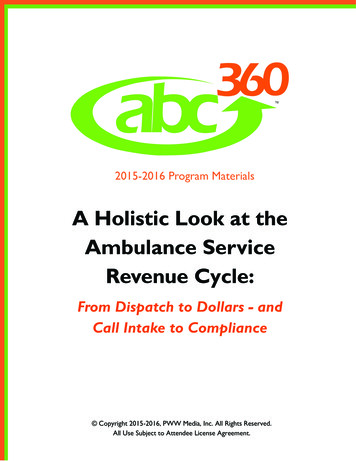
![MOH STANDARDS FOR EMERGENCY AMBULANCE SERVICE (2017) [Updated 21 Nov 2018]](/img/51/emergencyambulancestandards.jpg)



